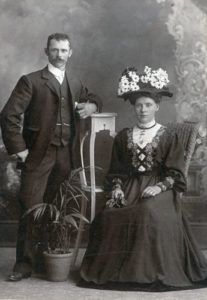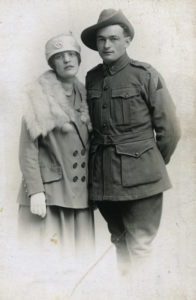Before the 1960’s hats were an essential part of anyone’s wardrobe. From the busy streets of London to the Country roads of Ipswich, no man, woman or child would be seen leaving the house without donning a fashionable or at least an appropriate piece of headwear.
For some it was purely a matter of sun safety – before the 1920’s having a tan was most unfashionable. This meant that the ladies of Ipswich would wear very large brimmed hats, boaters and bonnets to keep the hot Australian sun off their faces. For others it was a fashion statement; the bigger the hat the better your social standing. In 1910 the Queensland Times reported two ladies in London whose theatre hats were over one meter in diameter. The ladies were refused entry into the theatre on account of their hats being too large, obstructing the view of patrons in rows behind them.
During this period it was not only fashionable to wear large hats, it was essential that your hat was decorated with every type of flora and fauna imaginable. Flowers, ribbons, beads and fruit were all popular hat ornaments, along with fur and not only feathers but whole wings and birds themselves.
Heading towards the1920’s, a dramatic change in millinery fashion occurred. Most hats were very plain, as it was seen to be rather unpatriotic during the war years to wear the large and lavish hats that were all the craze just a few years before. Men were most often seen in military uniforms which included the “slouch hat”.
Just before the First World War the “slouch hat” became a standard issue headdress for all Australian military personnel. During the war it became a famous symbol of the Australian military man and is still an important national symbol today. The “slouch hat” was often made using rabbit-fur felt or wool felt.
Wool was an important product during the war and the Queensland Woollen Manufacturing Company at North Ipswich played an important role in supplying material for military uniforms and blankets all around the country.
Between the end of World War I and the beginning of World War II, a variety of hat styles were introduced, from knitted beret to sparkly snoods. Whatever was on the catwalks in Paris was on the streets in Ipswich. The people of Ipswich kept up to date with the latest hat fashions by reading the Millinery Forecast column in the Queensland Times, written from an exchange’s Paris correspondent. Looking around however, one thing was for sure, the days of the wide brimmed, extravagantly decorated hat was long gone. More and more women were working and opted for smaller hats that were easy to wear and easy to care for.
By the late 1940’s World War II was in effect and fashion had taken a backseat. With the rationing of material and the unpracticality of wearing a hat during war time, many people went without unless they were in military uniform.
The 1950’s saw the return of the wide brimmed straw hat. Although not as lavishly decorated as hats in the 1920’s the straw hats were large, they were also expensive and not everyone could afford to buy a new hat just to wear on special occasions. This saw the publication of articles in the Queensland Times about how to perform “Millinery Magic” on your old straw hat. Smaller hats for women were still very popular and were preferred when carrying out ones day to day business. Fashionable men’s hats also made a comeback in the 1950’s, after nearly two decades of little change. This decade saw the reinvention of the Fedora, Pork Pie and Bowler hats. Although the 1950’s seemed to be exploding with fashionable hats, it was the last decade where hats were a required fashion, giving in to the large beehive and bouffant hairstyles of the 1960’s.
Information taken from: The Queensland Times, 19 Oct, 1910; The Queensland Times, 6 Dec, 1913; The Queensland Times, 25 Aug, 1915; The Queensland Times, 11 May, 1931; The Queensland Times, 12 May, 1950; The Queensland Times, 8 Aug, 1951; Australian Army website; The Hat Book by Stephanie Talbot; The Fashion Archives website.


